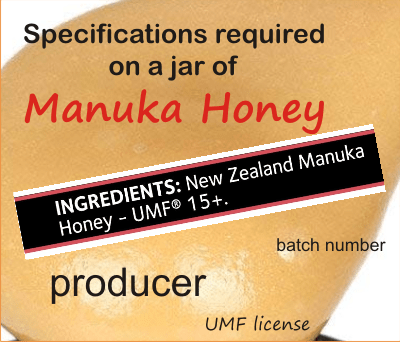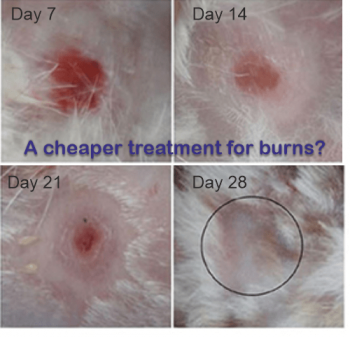Do not buy just any manuka honey. The number of fraudsters is increasing due to its high price and fame. Read the label of manuka honey correctly, see what UMF is and make sure you are buying genuine and therapeutic manuka honey.
Here are some statistics from 2013, when manuka honey was still not that famous:
The harvest of manuka honey in New Zealand was 1,700 tons. And the global consumption, which means people who claimed they ate manuka honey, was 10,000 tons. Only in the UK the consumption reached 1,800 tons.
So, what was the rest of the 8,300 tons? And this happened more than 10 years ago.
The harvest and the price is different every year. Weather is the most important factor when it comes to honey production. Buying the most expensive jar of manuka honey doesn’t mean you have the best manuka honey. It depends on the producer’s price, the importer’s price and the therapeutic grade of it. Manuka honey with UMF5+ will be way cheaper than one with UMF25+.
When buying a jar of manuka honey, the only thing one has to do, the most important one, is to read the label carefully. It will tell us everything we need to know.
– UMF® trademark on the front label (ranging from UMF5+ to UMF20+)
– New Zealand producer’s name
– producer’s UMFHA license number
– batch number
– UMFHA also recommends that manuka honey should be packed into jars and labelled in New Zealand.
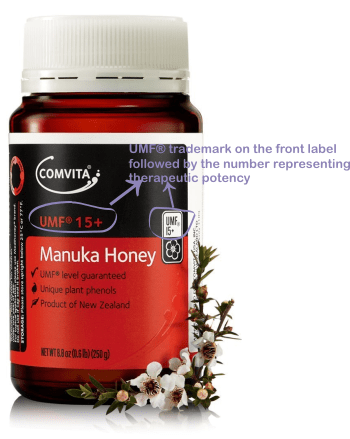
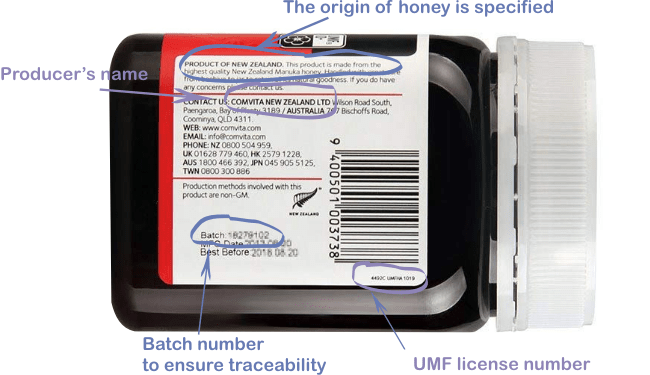
Starting with 2018, The Ministry for Primary Industries (MPI), New Zealand, has issued a science definition for manuka honey. All exported manuka honey will have to be verified by accredited laboratories and pass 2 tests: one verifying 4 chemical markers and one for manuka DNA. (see true markers of genuine New Zealand Manuka honey!).
There are many producers selling quality manuka honey, over 80% of all exported retail packs of manuka honey products from New Zealand. UMF factor is an important grade (ranging from 5 to 26) that tells us that manuka honey goes through all required tests and qualifies for a certain therapy.
The UMF grade is granted by UMFHA (Unique Manuka Factor Honey Association) from New Zealand and represents a standard of quality.
UMF grade tests the composition of important markers of manuka honey: Methylglyoxal (aka MGO), leptosperin, dihydroxyacetone (DHA).
Dihydroxyacetone (DHA) turns to MGO in time and with heat: higher temperatures accelerate the conversion. Fraudsters would heat it to quickly increase the content of MGO in order to make it more valuable commercially. However, when heated above 30°C another compound, hydroxymethylfurfural (HMF), is created in honey and this is a sign the honey was temperature-abused.
Hydroxymethylfurfural is used as an indicator of heat treatment and ageing. The CODEX Standard recommends a maximum limit of 40 mg/kg HMF in honey.
An UMF grade guaranties a level of HMF lower than 40 mg/kg.
Leptosperin is a naturally occurring chemical found only in the nectar of Manuka plants (and a few very close relatives). It was recommended by Comvita to be one of the attributes of manuka honey. Leptosperin concentration is stable over time, and therefore measuring its concentration in honey is a good way of identifying whether the honey comes from Manuka nectar, and whether it can be labelled as Manuka, as a Manuka blend, or as a multi-floral honey.
Methyglyoxal is not stable and shows a dramatic change. Due to the presence of DHA, the quantity of MGO will first increase in manuka honey, then decrease. It is not specific to manuka honey, on the contrary, there are honeys with much higher amounts of MGO (berringa honey).
Yet, the amount of MGO is used to grade the potency of honey.
All UMF grades have HMF under 40 mg/kg and Leptosperin 100mg/kg. The content of MGO is what differentiates them:
UMF5 has 83 mg/kg MGO
UMF6 has 113 mg/kg MGO
UMF7 has 146 mg/kg MGO
UMF8 has 182 mg/kg MGO
UMF9 has 222 mg/kg MGO
UMF10 has 263 mg/kg MGO
UMF11 has 308 mg/kg MGO
UMF12 has 356 mg/kg MGO
UMF13 has 406 mg/kg MGO
UMF14 has 459 mg/kg MGO
UMF15 has 514 mg/kg MGO
UMF16 has 572 mg/kg MGO
UMF17 has 633 mg/kg MGO
UMF18 has 696 mg/kg MGO
UMF19 has 761 mg/kg MGO
UMF20 has 829 mg/kg MGO
UMF21 has 899 mg/kg MGO
UMF22 has 971 mg/kg MGO
UMF24 has 1122 mg/kg MGO
UMF25 has 1200 mg/kg MGO
UMF26 has 1282 mg/kg MGO
What grade do I need?
When you buy it make sure you buy the grade that you need.
If you want to use it to boost your general state of health or to improve immunity, then UMF5+ to a maximum of 10+ is the one you need. Not higher. You can take it in the morning, before your breakfast, with some water. (it’s better than taking it alone)
If you have influenza or a simple cold sweeten your tea with it. Eat 3 full spoons per day. (as with any honey. And add lemon juice). Or more. The treatment should not last for more than 14 days.
Or, if you have a microbe like helicobacter pylori, or staphylococcus aureus, use a higher grade, like UMF10+ or UMF15+. Some therapists even recommend to take UMF20+ for short terms (4 weeks with 2 weeks break)
The highest grades are not recommended for internal use, but for external one, for very hard to heal wounds. UMF20+ or UMF25+ are the best. (see Manuka honey: THE BEST to treat wounds, burns, skin infections.)
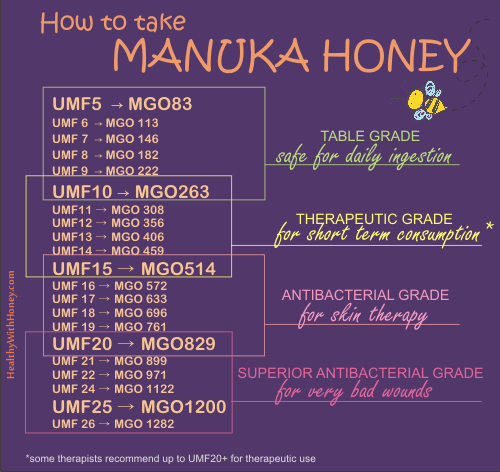
How do we know what producers are UMF licensed?
The UMFHA has listed all its members on its site. You can also verify them in this article. They are frequently updated and listed in alphabetical order, making them easy to spot.
Check them here: Make sure you buy genuine manuka honey! Check this list!
Aren’t the other producers, that do not have UMF, trustworthy?
Over 80% of all exported retail packs of Manuka honey products from New Zealand are UMF licensed. But this doesn’t mean that the rest of the 20% are not.
They may still sell genuine manuka honey, if tested for all the 5 attributes requested by the scientific definition of manuka honey.
But their labels must still be very explicit regarding the provenience of honey (that it is from New Zealand), the source (from manuka), the producer’s name and the batch number.
These producers may have a different grading system for therapeutic value like:
– the MGO content (Manuka Health)
– some letters like A (Active) or TA (Total Activity) or BioActive (like Manuka Doctor)
– the word KFACTOR (WEDDERSPOON)
Simple numbers do not stand for anything, those jars are not to be trusted.
To understand why there are so many grading systems and why they do not all comply with UMFHA, please read this article. Generally this happens due to each country’s politics and medical rules.
I recommend Comvita, the most appreciated honey by all consumers. Read here why: What is the best manuka honey? From what brand?
UMF is a highly sought-after and well-respected quality trademark that protects the consumer’s rights.
The interest of the world is continually growing, for example the Chinese market took 25% of total New Zealand honey exports in 2016/2017. And the growth in the Chinese market is driven by Chinese investment in the New Zealand beekeeping and honey industry.
But with the honest interest comes the selfish and mean one of … other type of people. Be careful when buying manuka honey, as nothing is more precious than your health. You better spend a little more money on honey produced by a trustful brand, than buying a cheaper one that can do even more harm.
***********
References:
https://www.analytica.co.nz/Tests/Honey-Testing/Manuka-Honey-3-in-1/DHA-and-MG-explained
https://www.mpi.govt.nz/dmsdocument/27678/loggedIn
https://www.analytica.co.nz/Tests/Honey-Testing/Leptosperin

